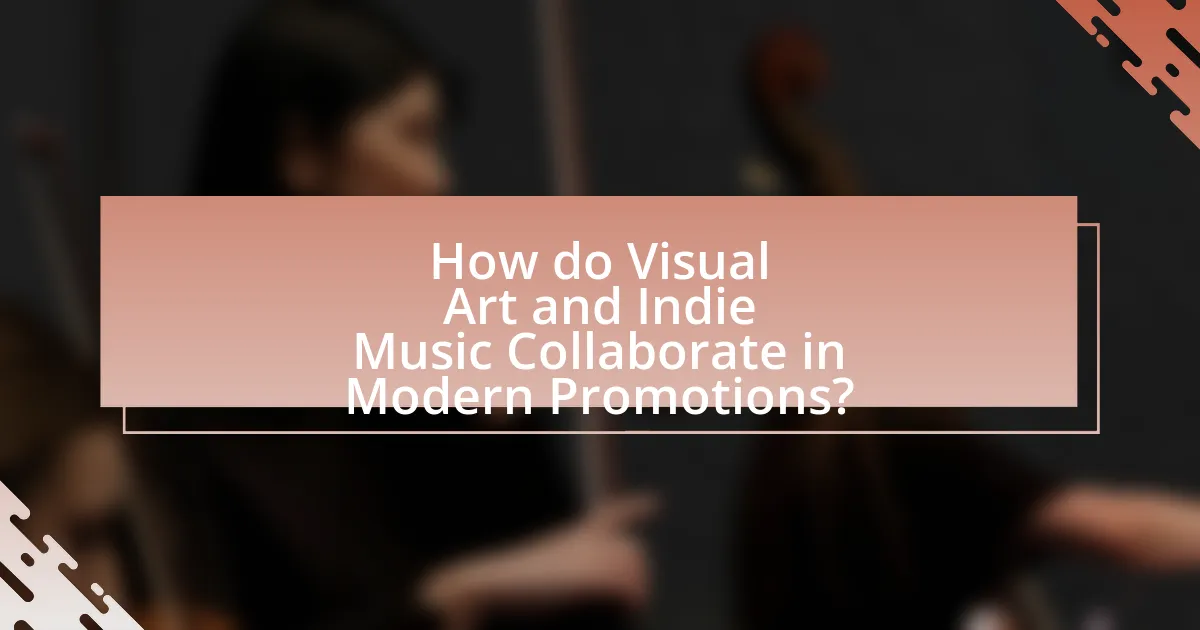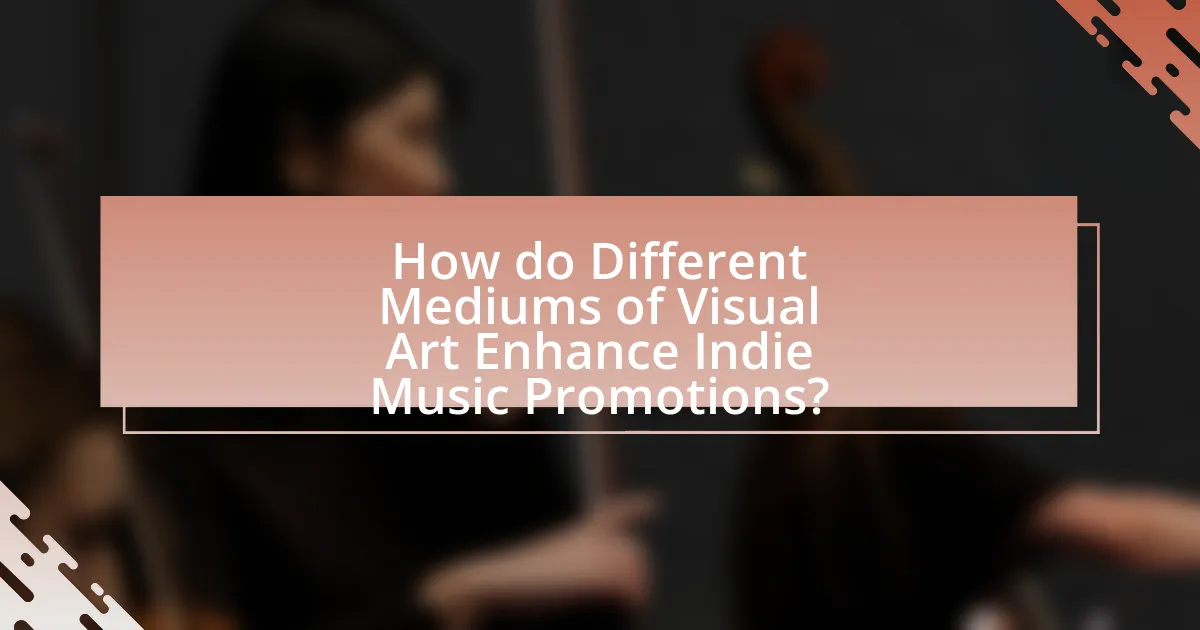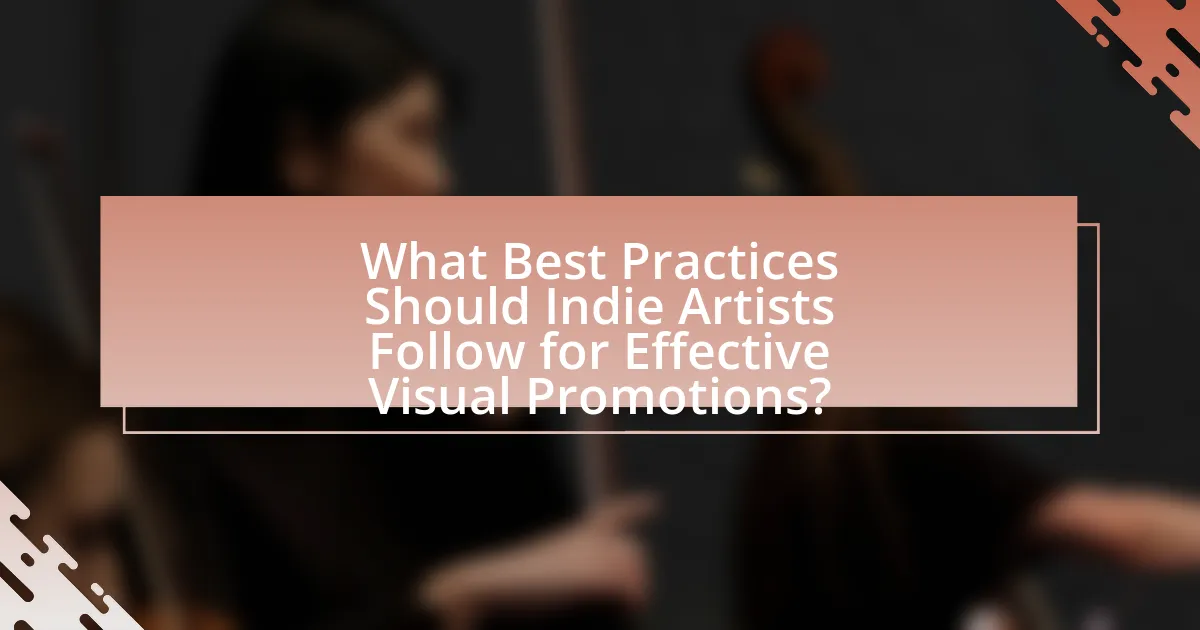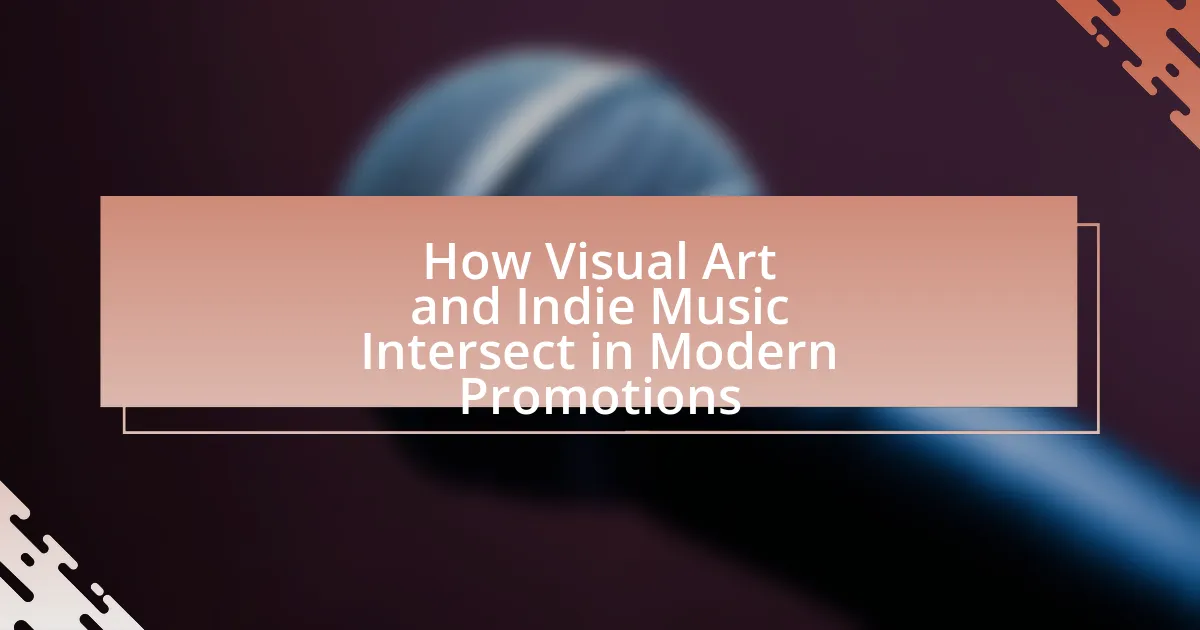The article explores the intersection of visual art and indie music in modern promotions, highlighting how these two forms of creativity collaborate to enhance audience engagement and marketing strategies. Key elements discussed include the role of album artwork, music videos, and social media visuals in shaping an artist’s identity and promoting their work. The article also examines the impact of visual branding on audience perception, the significance of immersive experiences through emerging technologies like augmented and virtual reality, and the challenges faced in integrating visual art with music promotions. Additionally, it outlines best practices for indie artists to effectively leverage visual art in their promotional efforts.

How do Visual Art and Indie Music Collaborate in Modern Promotions?
Visual art and indie music collaborate in modern promotions through the creation of visually engaging content that enhances the music experience. This collaboration often manifests in album artwork, music videos, and promotional materials that visually represent the themes and emotions of the music. For instance, artists like Sufjan Stevens have worked with visual artists to create immersive experiences that blend sound and imagery, effectively attracting a wider audience. Additionally, platforms like Instagram and TikTok enable indie musicians to showcase their music alongside visual art, increasing engagement and reach. This synergy not only amplifies the promotional impact but also fosters a deeper connection between the audience and the artistic expressions involved.
What are the key elements of Visual Art in Indie Music Promotions?
The key elements of visual art in indie music promotions include album artwork, promotional posters, music videos, and social media visuals. Album artwork serves as a visual representation of the music, often reflecting the themes and emotions of the songs, which can significantly influence listener engagement. Promotional posters are designed to attract attention to live shows and events, utilizing striking imagery and typography to convey the essence of the music. Music videos enhance storytelling and provide a visual narrative that complements the audio experience, often becoming a crucial part of an artist’s identity. Social media visuals, including graphics and images shared on platforms like Instagram and Facebook, play a vital role in building an artist’s brand and connecting with fans, as they are often the first point of interaction. These elements collectively enhance the overall promotional strategy, making visual art an integral part of indie music marketing.
How does visual branding influence audience perception in music?
Visual branding significantly influences audience perception in music by creating a cohesive identity that resonates with listeners. This identity is established through consistent imagery, color schemes, and design elements that reflect the artist’s style and message. For instance, research indicates that 93% of consumers make purchasing decisions based on visual appearance, highlighting the importance of visual branding in attracting and retaining audience attention. Additionally, artists like Billie Eilish utilize distinct visual branding, such as her signature green and black color palette, to enhance her music’s emotional impact and connect with fans on a deeper level. This alignment between visual elements and musical content fosters a stronger emotional connection, ultimately shaping how audiences perceive and engage with the music.
What role does album artwork play in the marketing of indie music?
Album artwork plays a crucial role in the marketing of indie music by serving as a visual representation of the artist’s identity and musical style. This visual element captures potential listeners’ attention, differentiates the artist in a crowded market, and communicates the themes or emotions of the music. Research indicates that 70% of consumers make purchasing decisions based on visual appearance, highlighting the importance of compelling artwork in attracting an audience. Additionally, platforms like Instagram and Spotify emphasize visuals, making striking album covers essential for engagement and shareability. Thus, effective album artwork not only enhances brand recognition but also contributes significantly to the overall marketing strategy of indie musicians.
Why is the intersection of Visual Art and Indie Music significant today?
The intersection of Visual Art and Indie Music is significant today because it enhances the promotional strategies of artists, creating a multi-sensory experience that engages audiences more deeply. This synergy allows indie musicians to visually express their brand and message through album artwork, music videos, and live performances, which can lead to increased visibility and audience connection. For instance, studies show that visual elements in music promotion can boost listener engagement by up to 60%, as they create a more immersive experience that resonates emotionally with fans. This collaboration not only enriches the artistic expression but also drives the commercial success of indie music in a competitive market.
How has social media changed the way visual art is used in music promotions?
Social media has transformed the use of visual art in music promotions by enabling artists to share their work directly with audiences, bypassing traditional gatekeepers. Platforms like Instagram and TikTok allow musicians to showcase album artwork, music videos, and promotional graphics instantly, reaching millions without the need for record labels or marketing firms. This shift has led to a more interactive relationship between artists and fans, as visual content can be tailored and adapted based on audience feedback in real-time. Additionally, studies show that posts featuring visual art receive higher engagement rates, with Instagram reporting that images generate 650% higher engagement than text-only posts, highlighting the importance of visual elements in capturing audience attention.
What cultural trends are driving the collaboration between visual artists and musicians?
The collaboration between visual artists and musicians is primarily driven by the rise of multimedia experiences and the increasing demand for cross-disciplinary creativity. This trend is fueled by the digital age, where platforms like social media and streaming services allow for the seamless integration of visual art and music, enhancing audience engagement. For instance, artists often create album covers, music videos, and live performances that incorporate visual elements, reflecting a holistic approach to artistic expression. Additionally, events like art and music festivals promote collaboration, showcasing how these two forms of art can complement each other and reach wider audiences.
What are the challenges faced in integrating Visual Art with Indie Music Promotions?
Integrating visual art with indie music promotions faces several challenges, primarily due to differing audience engagement strategies. Visual art often relies on static or dynamic visual experiences, while indie music promotions typically focus on auditory engagement and live performances. This divergence can lead to difficulties in creating cohesive marketing campaigns that resonate with both art and music audiences.
Additionally, logistical issues arise, such as coordinating events that effectively showcase both art and music, which can require significant resources and planning. Financial constraints also pose a challenge, as funding for visual art installations may not align with the budget allocated for music promotions. Furthermore, there is often a lack of collaboration between artists in these two fields, which can hinder innovative promotional strategies that leverage the strengths of both mediums.
Research indicates that successful integration requires a clear understanding of both audiences and their preferences, as well as a willingness to experiment with cross-disciplinary approaches.
How do budget constraints affect artistic collaborations in indie music?
Budget constraints significantly limit artistic collaborations in indie music by restricting access to resources necessary for high-quality production and promotion. Indie musicians often operate with minimal financial backing, which can hinder their ability to collaborate with visual artists, producers, or other musicians who require compensation for their work. For instance, a study by the Music Industry Research Association found that 70% of indie artists reported financial limitations as a barrier to collaboration, impacting their ability to create visually compelling promotional materials or innovative music videos. Consequently, these constraints can lead to less diverse artistic expressions and limit the overall reach and impact of indie music projects.
What are the common misconceptions about the role of visual art in music marketing?
Common misconceptions about the role of visual art in music marketing include the belief that visual elements are secondary to the music itself and that they only serve as mere decoration. In reality, visual art plays a crucial role in establishing an artist’s brand identity and enhancing audience engagement. Studies show that visuals can significantly influence consumer behavior; for instance, a report by Nielsen indicates that 93% of consumers’ purchasing decisions are influenced by visual appearance. Additionally, effective visual art can create emotional connections and convey messages that resonate with the target audience, making it an integral part of a comprehensive marketing strategy in the music industry.

How do Different Mediums of Visual Art Enhance Indie Music Promotions?
Different mediums of visual art enhance indie music promotions by creating a unique and engaging aesthetic that attracts audiences and strengthens brand identity. Visual art, such as album covers, music videos, and promotional posters, serves as a visual representation of the music, allowing artists to convey their themes and emotions effectively. For instance, a study by the University of Southern California found that visually appealing content increases audience engagement by up to 94%, demonstrating the importance of visual elements in capturing attention. Additionally, collaborations between indie musicians and visual artists can lead to innovative marketing strategies, expanding reach through cross-promotion on social media platforms. This synergy not only amplifies the artist’s message but also fosters a deeper connection with fans, ultimately enhancing the overall promotional impact.
What types of visual art are most commonly used in music promotions?
The types of visual art most commonly used in music promotions include album covers, posters, music videos, and social media graphics. Album covers serve as a visual representation of the music and are crucial for branding; for instance, iconic covers like Pink Floyd’s “The Dark Side of the Moon” have become cultural symbols. Posters are often used for concert promotions and feature striking imagery to attract audiences. Music videos combine visual storytelling with music, enhancing the listener’s experience; for example, the innovative visuals in OK Go’s “Here It Goes Again” have garnered millions of views. Social media graphics are essential for online promotion, utilizing eye-catching designs to engage fans and promote releases. These forms of visual art are integral to the marketing strategies of artists, particularly in the indie music scene, where unique and creative visuals can differentiate them in a crowded market.
How do illustrations differ from photography in promoting indie music?
Illustrations differ from photography in promoting indie music by offering a unique, stylized representation that can convey abstract concepts and emotions more freely than photography. While photography captures real-life moments and subjects, illustrations allow for creative interpretations, enabling artists to express their individuality and thematic elements in a way that resonates with the indie music ethos. For instance, album covers featuring illustrations can evoke a sense of nostalgia or whimsy that aligns with the music’s tone, as seen in the works of artists like Sufjan Stevens, whose illustrated album covers enhance the storytelling aspect of his music. This distinct visual approach can attract audiences seeking authenticity and originality, which are core values in the indie music scene.
What impact do digital art and animations have on audience engagement?
Digital art and animations significantly enhance audience engagement by creating visually stimulating experiences that capture attention and evoke emotional responses. Research indicates that visual content is processed 60,000 times faster than text, making digital art and animations effective tools for conveying messages quickly and memorably. For instance, a study by HubSpot found that incorporating visuals in marketing can increase engagement rates by up to 650%. This demonstrates that the integration of digital art and animations not only attracts viewers but also fosters a deeper connection with the content, ultimately leading to higher retention and interaction levels.
How can visual storytelling be effectively utilized in music promotions?
Visual storytelling can be effectively utilized in music promotions by creating engaging narratives that resonate with the audience, enhancing emotional connections to the music. For instance, artists can use music videos, album artwork, and social media visuals to convey themes and stories that reflect their music’s essence. Research indicates that visuals can increase audience retention by up to 65%, making it crucial for artists to integrate compelling imagery that complements their sound. Additionally, platforms like Instagram and TikTok allow musicians to share behind-the-scenes content, further deepening the audience’s engagement and investment in the artist’s journey.
What techniques can artists use to create compelling narratives through visuals?
Artists can create compelling narratives through visuals by employing techniques such as symbolism, color theory, composition, and storytelling elements. Symbolism allows artists to convey deeper meanings and emotions, as seen in works like Picasso’s “Guernica,” which uses imagery to represent the horrors of war. Color theory influences mood and perception; for instance, warm colors can evoke feelings of passion or urgency, while cool colors may suggest calmness or sadness. Composition techniques, such as the rule of thirds, guide the viewer’s eye and create a balanced narrative flow. Additionally, integrating storytelling elements, such as character development and conflict, can enhance the narrative depth, as demonstrated in graphic novels where visuals and text work together to unfold a story. These techniques collectively enable artists to engage audiences and communicate complex ideas effectively.
How does visual storytelling enhance the emotional connection with the audience?
Visual storytelling enhances the emotional connection with the audience by utilizing imagery and narrative to evoke feelings and create relatable experiences. This method engages viewers on a deeper level, as visuals can trigger emotional responses more effectively than text alone. Research indicates that stories accompanied by visuals are 65% more memorable than those without, demonstrating the power of visual elements in reinforcing emotional engagement. By combining visual art with narrative techniques, creators can foster empathy and connection, making the audience feel more invested in the story being told.

What Best Practices Should Indie Artists Follow for Effective Visual Promotions?
Indie artists should prioritize high-quality visuals, consistent branding, and audience engagement for effective visual promotions. High-quality visuals, such as professional photography and graphic design, enhance the perceived value of the artist’s work and attract attention. Consistent branding across all visual materials, including album covers, social media graphics, and promotional videos, helps establish a recognizable identity, which is crucial in a crowded market. Engaging with the audience through interactive visuals, such as behind-the-scenes content or fan art showcases, fosters a community around the artist and encourages sharing, which can amplify reach. Research indicates that visual content is 40 times more likely to be shared on social media than other types of content, underscoring the importance of effective visual strategies in promotions.
How can indie musicians collaborate with visual artists for maximum impact?
Indie musicians can collaborate with visual artists by integrating visual elements into their music branding, such as album covers, music videos, and promotional materials. This collaboration enhances the overall artistic expression and creates a cohesive identity that resonates with audiences. For instance, the partnership between musician Billie Eilish and visual artist Takashi Murakami resulted in striking visuals that amplified her brand and attracted a wider audience. Such collaborations can also leverage social media platforms, where visual content is highly engaging, to reach and connect with fans effectively.
What are the key factors to consider when choosing a visual artist for collaboration?
When choosing a visual artist for collaboration, key factors include artistic style, experience, and alignment with the project’s vision. Artistic style should resonate with the intended message and aesthetic of the project, ensuring a cohesive visual representation. Experience is crucial, as artists with a proven track record in similar collaborations can bring valuable insights and professionalism. Alignment with the project’s vision ensures that the artist’s creative approach complements the overall goals, enhancing the effectiveness of the promotional efforts. These factors collectively contribute to a successful partnership that can elevate both the visual and musical elements of the project.
How can artists ensure their visual and musical styles align effectively?
Artists can ensure their visual and musical styles align effectively by establishing a cohesive thematic concept that integrates both mediums. This involves creating visual art that reflects the emotions, narratives, and aesthetics present in their music, thereby enhancing the overall artistic expression. For instance, a study by the University of California found that visual elements in album covers significantly influence listener perceptions and emotional responses to music, demonstrating the importance of alignment between visual and auditory styles. By consciously designing visuals that resonate with the musical themes, artists can create a unified brand identity that strengthens their promotional efforts in the indie music scene.
What strategies can indie musicians implement to leverage visual art in their promotions?
Indie musicians can leverage visual art in their promotions by collaborating with visual artists to create unique album covers, merchandise, and promotional materials. This strategy not only enhances the aesthetic appeal of their brand but also fosters a cross-promotion opportunity, as artists share the work with their own audiences. For instance, a study by the University of Southern California found that visual elements significantly increase engagement on social media platforms, leading to a 94% increase in views when visuals accompany music content. Additionally, hosting art shows or exhibitions that feature both the musician’s work and the visual artist’s creations can attract diverse audiences and create a memorable experience that strengthens community ties.
How can social media platforms be used to showcase visual art in music promotions?
Social media platforms can be used to showcase visual art in music promotions by allowing artists to share images, videos, and live streams that highlight their artwork alongside their music. For instance, platforms like Instagram and TikTok enable musicians to create visually engaging content that combines their music with artistic visuals, attracting a wider audience. According to a 2021 report by Hootsuite, 54% of consumers want to see more video content from brands, indicating that integrating visual art with music can enhance engagement and reach. Additionally, artists can collaborate with visual creators to produce unique promotional materials, further blending the two art forms and expanding their promotional strategies.
What are the benefits of creating limited edition merchandise featuring visual art?
Creating limited edition merchandise featuring visual art enhances brand exclusivity and drives consumer interest. This strategy appeals to collectors and fans who value unique items, thereby increasing perceived value and demand. According to a study by the National Endowment for the Arts, limited edition art can appreciate in value over time, making it an attractive investment for consumers. Additionally, such merchandise fosters a deeper connection between artists and their audience, as fans often feel a sense of ownership and pride in possessing a unique piece of art. This connection can lead to increased loyalty and engagement with the artist’s brand, ultimately benefiting both the artist and the merchandise sales.
What are the future trends in the intersection of Visual Art and Indie Music Promotions?
Future trends in the intersection of visual art and indie music promotions include increased collaboration between artists and musicians, the use of augmented reality (AR) and virtual reality (VR) for immersive experiences, and the rise of social media platforms as primary promotional tools. Collaborations are becoming more common as visual artists create album covers, music videos, and live performance visuals, enhancing the overall artistic experience. The integration of AR and VR allows audiences to engage with music in innovative ways, such as virtual concerts or interactive art installations that accompany music releases. Additionally, platforms like Instagram and TikTok are increasingly utilized for promotional campaigns, enabling artists to reach wider audiences through visually engaging content. These trends reflect a growing recognition of the synergy between visual art and music in creating compelling promotional narratives.
How might emerging technologies influence the collaboration between visual artists and musicians?
Emerging technologies significantly enhance collaboration between visual artists and musicians by facilitating innovative forms of expression and interaction. For instance, virtual reality (VR) and augmented reality (AR) allow artists to create immersive experiences that blend visual art with music, enabling audiences to engage with both mediums in a cohesive environment. Additionally, platforms like social media and streaming services provide artists with tools to share their work collaboratively, reaching wider audiences and fostering cross-disciplinary projects. The integration of artificial intelligence (AI) in music production and visual design also enables artists to experiment with new styles and techniques, pushing the boundaries of traditional art forms. These advancements demonstrate how technology not only streamlines the collaborative process but also inspires creativity and innovation in the intersection of visual art and indie music.
What role will virtual reality and augmented reality play in future music promotions?
Virtual reality (VR) and augmented reality (AR) will play a transformative role in future music promotions by creating immersive experiences that engage audiences in novel ways. These technologies allow artists to host virtual concerts, enabling fans to attend live performances from anywhere in the world, thus expanding their reach and accessibility. For instance, platforms like Oculus Venues have already demonstrated the potential of VR concerts, where users can experience live shows in a virtual environment, enhancing the emotional connection to the music. Additionally, AR can be utilized in promotional materials, such as album covers or merchandise, to provide interactive content that deepens fan engagement. A study by the International Music Summit in 2021 highlighted that 70% of music fans expressed interest in attending virtual events, indicating a strong market potential for VR and AR in music promotions.

![The Role of Social Media in [Band Name]’s Rise to Fame](https://therooksband.com/wp-content/uploads/Featured-image-The-Role-of-Social-Media-in-Band-Names-Rise-to-Fame-150x150.webp)